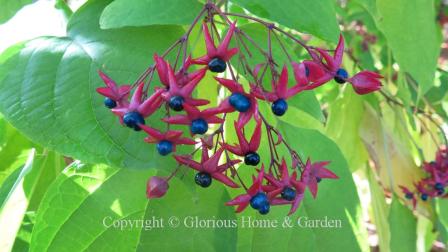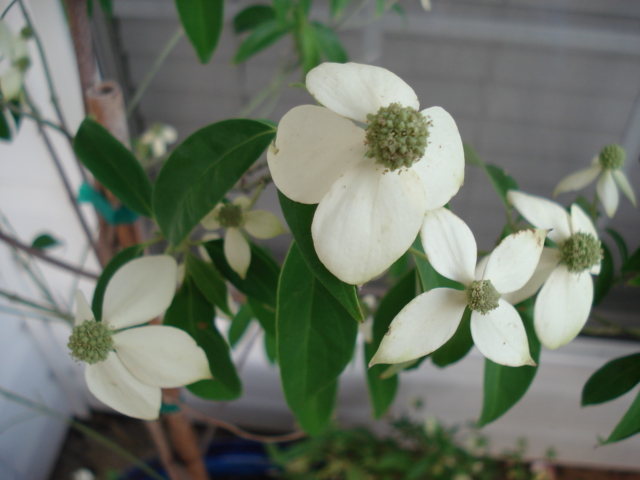How To Grow And Care For The Harlequin Glorybower Clerodendrum Trichotomum
Additional Information:
Here are some additional tips for growing and caring for Harlequin Glorybowers:
- Mulch around the plant to help retain moisture and suppress weeds.
- Deadhead spent flowers to encourage new blooms.
- Protect the plant from strong winds, which can damage the branches.
Clerodendrum trichotomum, also known as the harlequin glorybower, glorytree, or peanut butter tree, is a beautiful and versatile plant that can be grown as a shrub, tree, or houseplant. It is native to China, Korea, Taiwan, Japan, India, and the Philippines.
The harlequin glorybower has large, oval leaves that are soft and downy or hairy, and they produce a peanut odor when crushed. The flowers are fragrant and borne on branching peduncles. They have white petals, held within a green calyx which turns red as the fruits ripen.
The harlequin glorybower is a hardy plant that can tolerate a wide range of conditions, but it prefers full sun and well-drained soil. It is also drought-tolerant once established.
If you are interested in learning more about Clerodendrum trichotomum, please visit Home Gardening.
FAQ of clerodendrum trichotomum
- How do you propagate Clerodendrum trichotomum?
Clerodendrum trichotomum can be propagated by sowing seed in spring or by taking cuttings of half-hardened wood during winter or summer.
To sow seed, sow the seeds in a well-draining potting mix and keep the soil moist. The seeds should germinate in about 2-4 weeks.
To take cuttings, cut a 4-6 inch piece of half-hardened wood from the plant. Remove the leaves from the bottom half of the cutting and dip the cut end in rooting hormone. Plant the cutting in a well-draining potting mix and keep the soil moist. The cutting should root in about 4-6 weeks.
- What are the medicinal uses of Clerodendrum trichotomum?
Clerodendrum trichotomum has been used in traditional medicine for a variety of purposes, including:
- Treating hypertension
- Relieving arthritis pain
- Reducing inflammation
- Improving wound healing
- Preventing hyperuricemia
However, more research is needed to confirm the effectiveness of Clerodendrum trichotomum for these uses.
- Is Clerodendrum trichotomum toxic?
Clerodendrum trichotomum is not considered to be toxic to humans or animals. However, the leaves and flowers of the plant can cause skin irritation in some people. If you experience skin irritation after coming into contact with Clerodendrum trichotomum, wash the affected area with soap and water.
- What are the care requirements for Clerodendrum trichotomum?
Clerodendrum trichotomum is a relatively easy plant to care for. It prefers full sun to partial shade and well-draining soil. Water the plant regularly, but allow the soil to dry out slightly between waterings. Fertilize the plant once a month during the growing season.
- What are some common problems with Clerodendrum trichotomum?
Some common problems with Clerodendrum trichotomum include:
- Leaf spot
- Root rot
- Mealybugs
- Aphids
If you notice any problems with your Clerodendrum trichotomum plant, you can treat them with a commercial pesticide or insecticidal soap.
Image of clerodendrum trichotomum
10 different images of Clerodendrun trichotomum that are free to use:
- Flowering Clerodendrun trichotomum shrub with white flowers.

- Clerodendrun trichotomum shrub with dark green leaves.

- Clerodendrun trichotomum shrub with red berries.

- Clerodendrun trichotomum shrub in full bloom.

- Close-up of Clerodendrun trichotomum flowers.

- Clerodendrun trichotomum leaves with silvery undersides.
- Clerodendrun trichotomum shrub in a garden setting.
- Clerodendrun trichotomum shrub as a hedge.

- Clerodendrun trichotomum shrub in a pot.

- Clerodendrun trichotomum shrub in winter.

I hope you like these images!
Post a Comment for "How To Grow And Care For The Harlequin Glorybower Clerodendrum Trichotomum"